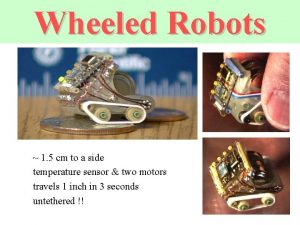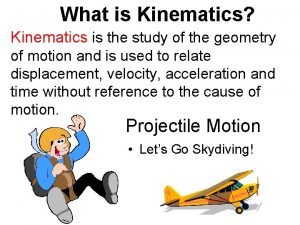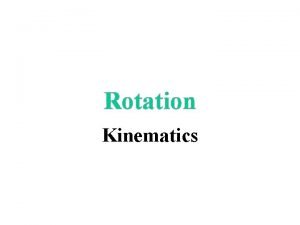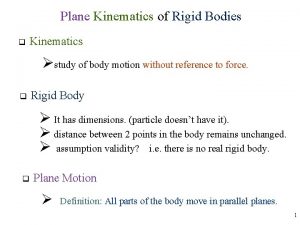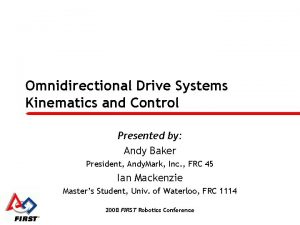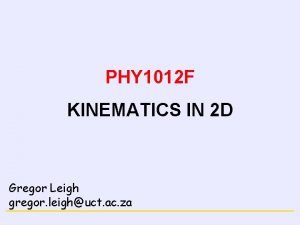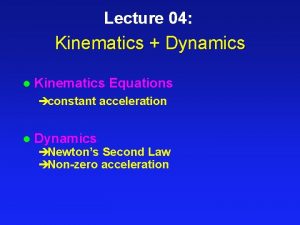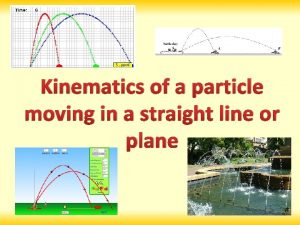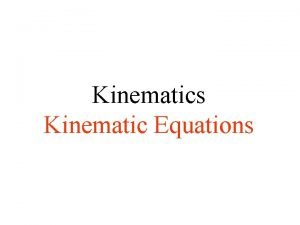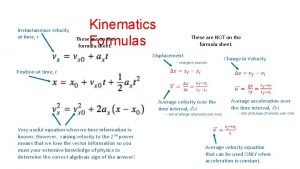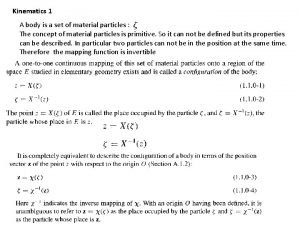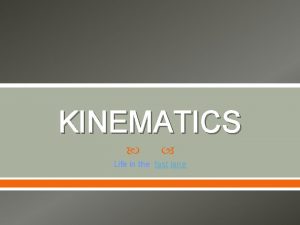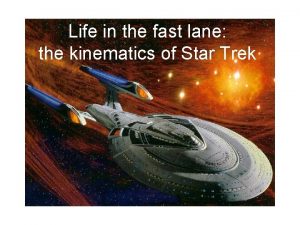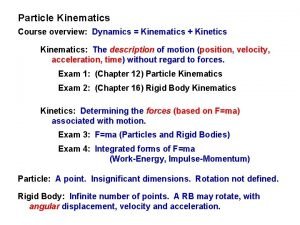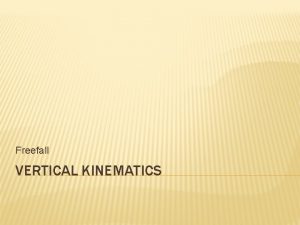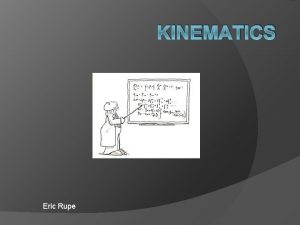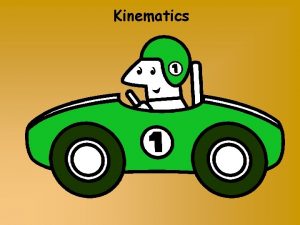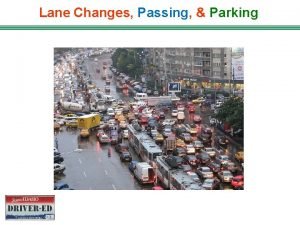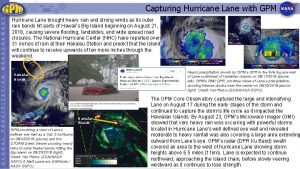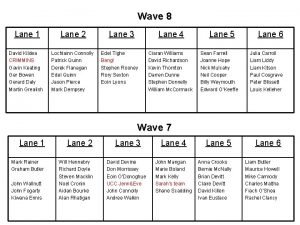Life in the fast lane the kinematics of



















- Slides: 19

Life in the fast lane: the kinematics of Star Trek

Hendrik Lorentz: a guy who was almost as smart as Einstein Maxwell’s highly successful equations… Gauss’ law no magnetic monopoles In the 19 th century, these equations were thought to hold only in the luminiferous ether! Faraday’s law Ampere’s law Lorentz wanted to make these equations covariant (the same in all reference frames). He came up with the Lorentz transformation: Contain a constant velocity! Recognize this?

• Postulate 1 – The laws of nature are the same in all inertial frames of reference • Postulate 2 – The speed of light in a vacuum is the same in all inertial frames of reference. • Let us analyze these postulates mathematically

S v Galilean transformation from S to S’: S’ x x’ Guess that the relativistic version has a similar form but differs by some dimensionless factor G: (we know that this must reduce to the Galilean transformation as v/c ->0) The transformation from S’ to S must have the same form: From first postulate of relativity-laws of physics must have the same form in S and S’ substitute solve for t’, you get: into

Now we need an expression for the velocity dx’/dt’ in the moving frame: Take derivatives of: where u=dx/dt From second postulate of relativity- the speed of light must be the same for an observer in S and S’ u=dx/dt=c u’=dx’/dt’=c Plug this into: Solve for G: and get:

The Lorentz transformations! S v S’ x The transformation: x’ To transform from S’ back to S: Bonus velocity addition:

Coordinate systems Let’s look at this another way: thinking Newtonianly… x’ y y’ x Roll cat toy across the floor towards cat. By Pythagorean’s theorem, the toy rolls: The same cat, the same cat toy, different (arbitrary) choice of coordinate systems. Easier visualization Rotation transformations: This is an example of rotating your coordinate axes in space. Distance is preserved.

Time, the fourth dimension? “Spacetime” In the previous slide, the two space dimensions were shown to be interchangeable. A similar relationship can be used to express the relationship between space and time in relativity. ct Light propagating in one dimension in a spacetime coordinate system as viewed from a frame S. The distance traveled is equal to the speed of light times the time elapsed. x=ct x’=ct’ x

Space-time Diagrams

Lorentz approach to Einstein Simultaneity: events simultaneous in one frame with distance D Time dilation: t 0 = proper time = time in clock rest frame Length contraction: L= length of ruler in moving frame (measured at the same time)

Light cones The red and blue spaceships are at x=0, t=0 when one emits a pulse of light. At that instant one of the spaceships starts to move away from the other with velocity v. The lightcone- the distance light has traveled since x=0, t=0 as a function of time. Who perceives him/herself to be at the center of the lightcone? A passenger on the red spaceship or a passenger on the blue spaceship?

The red spaceship’s reality. The blue spaceship’s reality. They are both at the center of the light cone! This can be achieved by rotating their coordinate axes as when playing with the cat, except one thing…notice that one set of axes is not orthogonal! You need to add a Lorentz boost.

ct ct’ x=ct x’ x The axes aren’t perpendicular but are scaled by some factor. They must be symmetric w/r to the light pulse. What is this factor?


Invariant “distances” in Spacetime! ct ct’ E 2 x=ct To find the space and time coordinates of an event in a specific frame, draw lines from the event parallel to the axis of that frame. True, observers will differ on the length of objects or the time events occurred, however, there is a space-time “distance” that moving observers agree on. E 1 x’ x This distance has to be invariant under Lorentz transformations and we can guess based on analogy with the Galilean case But what is a? !

Could an event at O cause A? where light that is here now may go in the future x=-ct ct A B x=ct C here, now O x Yes, because a “messenger” at O would not have to travel at a speed greater than the speed of light to get there. Could an event at O cause B? A light signal sent from O could reach B. Could an event at O cause C? where light that is here now may have been in the past No, the spacetime distance between O and C is greater than could be covered by light. It would require time travel.

Another Einstein from Lorentz (Doppler) Light wave takes the form (in any frame): In a moving frame it looks like:

One more thought about the kinematics of Star Trek: (elaboration of homework) The enterprise is speeding along at some “realistic” velocity (less than the speed of light). Let’s pretend that these stars emit light of a single wavelength. Will a passenger on the enterprise perceive the star to be the same color as a passenger on a Klingon ship that is hovering near the star? (Hint, think about Doppler effect)

 Aplusphysics kinematics-horizontal kinematics
Aplusphysics kinematics-horizontal kinematics Outside lane vs inside lane
Outside lane vs inside lane Differentiate between acid fast and non acid fast bacteria
Differentiate between acid fast and non acid fast bacteria Example of acid-fast bacteria
Example of acid-fast bacteria The major cause
The major cause Hold fast to your dreams for without them life is a broken
Hold fast to your dreams for without them life is a broken Differential drive inverse kinematics
Differential drive inverse kinematics Kinematics is the study of
Kinematics is the study of 2d motion equations
2d motion equations Rotational motion equations
Rotational motion equations Angular motion equations
Angular motion equations Iczv
Iczv Swerve drive kinematics
Swerve drive kinematics Range motion
Range motion Dr frost further kinematics
Dr frost further kinematics Constant acceleration equations
Constant acceleration equations Kinematics of a particle moving in a straight line
Kinematics of a particle moving in a straight line Kinematic formulas
Kinematic formulas Kinematic formula sheet
Kinematic formula sheet Transport theorem kinematics
Transport theorem kinematics






